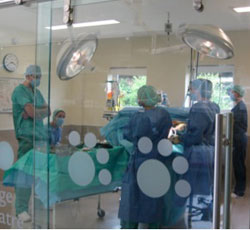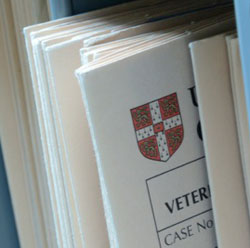Sixth Year
During the 6th year, which is lecture free, students work through a series of 40 weeks of ‘rotations’ in the different areas and clinics of the Hospital. These rotations provide opportunities for students to:
• Develop skills and techniques used in veterinary practice.
• Gain clinical experience in diagnosis, management and care of patients.
• Gain experience in client and peer communication.
• Develop and build on their academic knowledge.
Clinical cases are used as the main basis of teaching, although this is supplemented by ward rounds, seminars and practical classes. Students are also required to prepare written and oral presentations during the rotations. Students attend a two-week induction activities at the end of their 5th year, to prepare them for the 6th year rotations. Students are assessed during their rotations and the marks are brought forward to the Final Vet MB Part III exam (see below).
During their 6th year, students will also complete an elective project, on a subject of their choice. They will undertake a total of 8 weeks work towards this project, 4 of which will be undertaken after the Final Vet MB Part III exams in April/May.
Assessment: Students must complete written papers and viva exams which comprise the Final Vet MB Part III, and also pass their elective project. After passing these exams, they will be eligible to receive the VetMB degree, which entitles them to be admitted to the Royal College of Veterinary Surgeons and, therefore, to practice as a veterinary surgeon.
A brief description of each rotation is given below.
Small Animal Surgery (Soft Tissue and Orthopaedic Surgery)
This rotation aims to help the student
- develop skills and techniques used in small animal surgery

- gain clinical experience in managing surgical cases from admission to discharge and follow-up
- develop skills in client communication
- build on their ability to work as a team and solve clinical problems using knowledge they already have
Small Animal Medicine (including Oncology, Neurology and Clinical Pathology)
The main aims of this rotation are to develop skills and techniques used in small animal practice, to gain clinical experience in diagnosis, management and care of patients, to gain experience in client communication and to develop and build on your academic knowledge of small animal medicine, oncology, neurology and clinical pathology.
Equine Studies
The main aims of this rotation are to provide opportunities for students
- To practice and develop clinical skills on out-patients and in-patients.
- To become familiar with history taking, physical examination, problem solving, preparation of differential diagnoses and formulation of a logical diagnostic and therapeutic plan.
- To apply practical diagnostic techniques e.g. lameness evaluation, radiology, ultrasonography, endoscopy and scintigraphy.
Farm Animals
The Farm Animal rotation aims to develop skills and techniques used in farm animal practice, to gain clinical experience in diagnosis, management and care of patients, to gain experience in client communication and to develop and build on the student’s academic knowledge of farm animal medicine.
Anaesthesia
The purpose of this rotation is to develop skills and techniques used in the administration of anaesthesia and analgesia in small animals, to have an appreciation of anaesthetic techniques in large animals and to gain clinical experience in the peri-operative management and care of patients through risk assessment, monitoring and the administration of appropriate interventions.
 Out-of-hours care
Out-of-hours care
This rotation aims, for example, to assist in monitoring and managing patients in the hospital, (including the Intensive Care Unit [ICU]), and to learn a comprehensive, thorough approach to case management, to develop skills in pain recognition and management in hospitalised patients, and to develop a patient centred approach to hospitalised care.
Radiology
This rotation aims, for example, to ensure that students are competent to carry out radiographic examinations, correctly position animals, are familiar with cassettes, grids, exposure factors and relevant safety guides and to ensure students are able to present radiological reports both verbally and also in written form.
